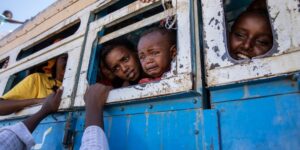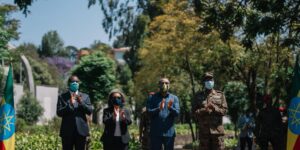he UN refugee agency UNHCR said the number of refugees “is likely to rise sharply” and urged neighbouring countries to keep their borders open.
The agency said it was also deeply concerned for more than 96,000 Eritreans living in four refugee camps in Tigray, as well as for humanitarian workers.
“Roads are blocked and electricity, phone and internet are down, making communication nearly impossible. There is a shortage of fuel, and banking services have halted resulting in a lack of cash,” said UNHCR.
Tigray has been under a communications blackout since the military operation was launched on November 4, making it difficult to verify the situation on the ground as both sides make conflicting claims.
The head of the army’s indoctrination division Mohammed Tessema said the city of Humera in western Tigray was “under the full control” of the army.
“The army is currently recapturing places on the road from Humera city to Sheraro city,” further south, the state owned Ethiopian News Agency quoted him as saying.
The head of the Ethiopian army northern division, Major General Belay Seyoum, told national media on Tuesday evening that 550 enemy combatants had been killed and 29 captured so far.
When Abiy Ahmed was appointed prime minister two years ago by the ruling coalition, the Ethiopian People’s Revolutionary Democratic Front (EPRDF), he was the first Oromo ever to govern the country, even though the Oromo are the largest of Ethiopia’s many ethnic groups (a third of the population). They have been unhappy for a long time, so that was a plus.
So was the fact that he was the son of a Christian-Muslim marriage, useful in a country that is two-thirds Christian, one-third Muslim. And Abiy’s intentions were good. He immediately set about to dismantle the stranglehold on power of the various ethnic militias that had fought and won the long war against the Derg, the previous Communist dictatorship.
THE MOST powerful of those militias is the Tigray People’s Liberation Front. Tigray, the country’s northernmost province, has six million people, a mere 5% of Ethiopia’s population, but Tigrayan soldiers and politicians have dominated the EPRDF coalition and government for most of the last 30 years because of their historic role in the war against the Derg.
The Tigrayan political elite’s privilege was widely resented, and it was time for it to end. Last year, Abiy tried to do that by merging all the ethnic militia-based parties into a single Prosperity Party, but the TPLF leadership wouldn’t play. They had always lived in the castle, and nobody was going to make them go and live with the commoners.
It is, alas, as simple as that, and perhaps a more accomplished civilian politician could have finessed it: cabinet posts, ambassadorships and/or fat lifetime pensions for the more flexible Tigrayan leaders, discreet but massive bribes for the greedier ones, and a couple of fatal “accidents” for the hardest nuts.
Abiy Ahmed Ali, despite a background in intelligence work that should have given him good political skills, is inflexible and confrontational. The cascade of threats, counter-threats and ultimatums between him and the TPLF leadership is now culminating in what amounts to a Tigrayan war of secession.![]()
It could be a long war, because Tigrayans are over-represented in the armed forces, and much of the army’s heavy weapons and equipment, which were based in Tigray because of the border war with Eritrea, has fallen into the TPLF’s hands. The TPLF has no air force, but it can match the federal army in everything up to and including mechanized divisions.
Ethiopia has the second-highest population among countries in Africa. It is very poor but has a fast-growing economy. The very last thing it needs is yet another civil war, which in current circumstances could also lead to other regions trying to secede. Even if the TPLF was trying to provoke a war (which looks quite likely), Abiy’s first duty was to avoid it at all costs.
Abiy received the Nobel Peace Prize last year for bringing Ethiopia’s 22-year border war with Eritrea to a formal end, however, that award has been going downhill ever since Henry Kissinger got one in 1973. They even gave one to Myanmar leader Aung San Suu Kyi, who now goes around condoning genocide.
- Lideta Sub City Woreda celebrated International Women’s Day - 11th March 2024
- THE AMHARA FANO FREEDOM FIGHTERS - 13th February 2024
- GREAT VICTORY FROM SHOWA GOVERNORATE - 12th February 2024




